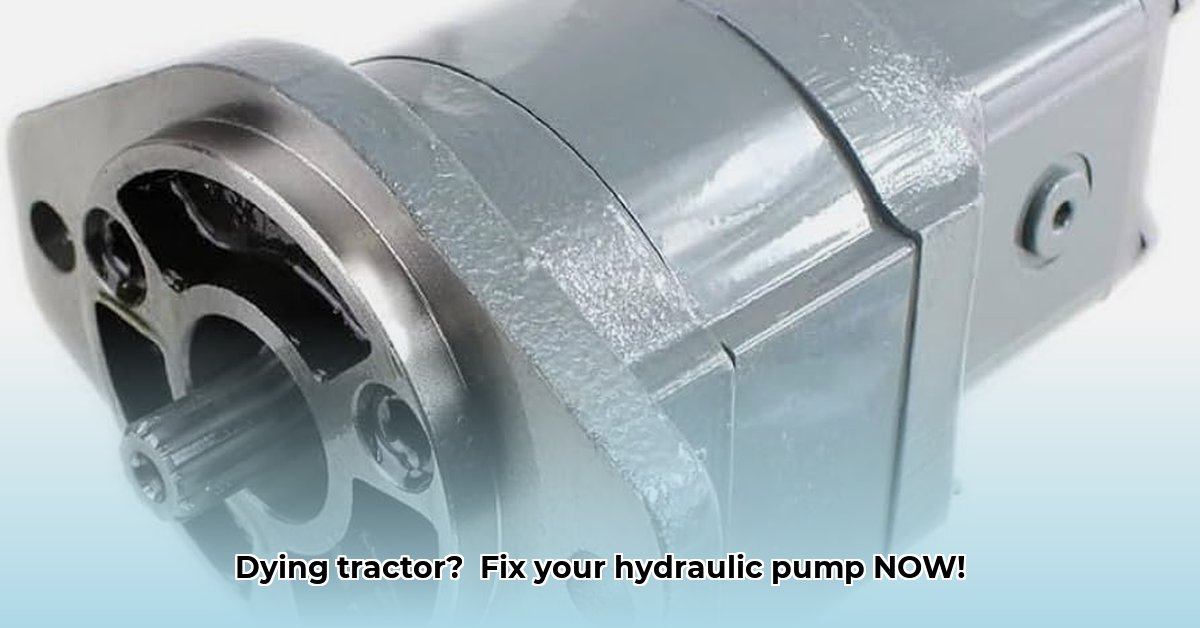
Understanding Your Tractor's Hydraulic Pump
Your tractor's hydraulic system is crucial for its operation, powering everything from lifting implements to steering. The heart of this system is the tractor hydraulic pump, responsible for moving hydraulic fluid throughout the system. Understanding its function and maintenance is key to maximizing your tractor's efficiency and lifespan. Ignoring problems can lead to costly repairs and significant downtime. Don't let a faulty pump hinder your productivity – let's get started. For more information on hydraulic oil capacity, check out this helpful resource: Kubota hydraulic oil capacity.
Types of Tractor Hydraulic Pumps
Several types of hydraulic pumps exist, each with unique characteristics:
Gear Pumps: Simple, reliable, and inexpensive, gear pumps are ideal for smaller tractors and lighter implements. However, they offer lower pressure and flow rates compared to other types.
Vane Pumps: These pumps offer higher pressure and flow than gear pumps, making them suitable for medium-sized tractors and moderately heavy-duty applications. They are slightly more complex and potentially more expensive to maintain.
Piston Pumps: Providing the highest pressure and flow, piston pumps are best suited for large tractors and heavy-duty implements, handling the most demanding tasks. They are the most complex and require specialized maintenance.
The choice of pump depends on your tractor's size, the implements you use, and the intensity of your work. A small, low-pressure system might only need a gear pump, while a large tractor performing heavy lifting will require a powerful piston pump. Are you using the right pump for your needs?
How Tractor Hydraulic Systems Work
A tractor's hydraulic system operates on the principle of moving hydraulic fluid under pressure to perform work. The pump draws fluid from a reservoir, pressurizes it, and sends it through various actuators (e.g., hydraulic cylinders and motors) that perform different actions. The system also includes valves to control fluid flow and pressure, and filters to remove contaminants.
Simplified Hydraulic System Schematic: [ Diagram would go here, showing reservoir, pump, valves, actuators, and return line. ]
Understanding this basic flow is important for troubleshooting and maintenance. A disruption anywhere in this flow can signal a problem in your system, often pinpointing the pump as the likely culprit.
Troubleshooting Common Problems
Several issues can signal a problem with your tractor's hydraulic pump. Early detection is key to preventing further damage.
Low Hydraulic Pressure: If equipment struggles to lift or move, or performs noticeably slower, check fluid levels, inspect for leaks, and examine the filter for blockages. Low pressure is the most common sign of a failing pump. Are your implements sluggish? This is a clear sign you need to investigate.
Unusual Noises: Grinding, whining, or squealing sounds from the hydraulic system often indicate wear or damage within the pump. Address these immediately to prevent major repairs. Is your pump making odd noises? Don't delay checking it out.
Overheating: Excessive hydraulic system heat can damage components. Check fluid levels, ensure proper cooling system function, and inspect for blockages—overheating often points to a problem with the pump being overworked or compromised. Is your hydraulic fluid too hot to touch? This indicates a serious issue demanding immediate attention.
Leaks: Even small leaks should be addressed promptly. Hydraulic fluid leaks waste expensive fluid, damage components, and pose a safety hazard. Are you noticing fluid pooling under your tractor? This is a critical sign of a leak.
Preventative Maintenance: A Proactive Approach
Regular maintenance is far more cost-effective than emergency repairs.
Fluid Changes: Follow your tractor's owner's manual for recommended fluid change intervals. Using the correct type and grade of hydraulic fluid is vital. Dirty fluid can severely damage your pump.
Filter Replacements: Clogged filters restrict fluid flow, reducing pump efficiency. Replace filters as scheduled.
Regular Inspections: Visually inspect the system for leaks, wear, loose connections, or abnormalities. Addressing small issues early can prevent bigger problems down the line. Daily checks can make a significant impact on preventing bigger issues.
Safety Precautions: Handling Hydraulic Systems Safely
Hydraulic systems operate under high pressure; safety is paramount.
Always relieve pressure: Before working on any part of the system, always relieve the pressure completely. Consult your owner's manual for the specific procedure.
Use proper safety equipment: Always wear safety glasses, gloves, and other appropriate protective gear.
Consult your manual: Your tractor's owner's manual contains essential safety information—always follow it!
Selecting the Right Pump
Choosing the appropriate pump depends on your tractor's size, the implements you use, and the demands of your work. Consult your tractor's specifications and consider the tasks you undertake to make an informed decision.
Conclusion: Keeping Your Tractor Running Strong
A well-maintained hydraulic pump is crucial for efficient and productive farming. Regular maintenance, prompt attention to warning signs, and a basic understanding of your system can save you time, money, and frustration. Regular maintenance is the key to keeping your tractor hydraulic system healthy and productive.